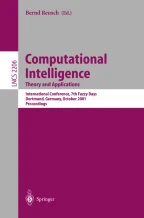Abstract
Clustering on non-metric data sets often occurs in investigations in medicine and social science. The problem is to find suitable measures which describe similaries and, hence, are applicable to the clustering algorithms. In the present contribution we use evolutionary algorithms EA for clustering. Thereyby, the similarity measures determine the respective fitness function for the EA. We consider several fitness functions and derive a new one which allows, additionally, the determination of a useful cluster number. — For the EA we use a new selection starateguy and a multiple subpopulation approach with a migration scheme following the collective learning dynamic in self-organizing maps.
Access this chapter
Tax calculation will be finalised at checkout
Purchases are for personal use only
Preview
Unable to display preview. Download preview PDF.
Similar content being viewed by others
References
J. Buhmann, H. Kühnel, Vector quantization with complexity costs, IEEE Transactions on Information Theory 39 (1993) 1133–1145.
F. Ermini, C. Marchesi, Intelligent data retrieval from multidimensional clinical archives, in E. Ifeachor, A. Sperduti, A. Starita (Eds.), Neural Networks and Expert Systems in Medicine and Healthcare, World Scientific, Singapore, New Jersey, London, Hongkong, 1998, pp. 295–303.
M. Hasenjäger, H. Ritter, Active learning with local models, Neural Processing Letters 7 (1998) 101–117.
T. Hofmann, J. Buhmann, Pairwise data clustering by deterministic annealing, IEEE Transactions on Pattern Analysis and Machine Intelligence 19(1) (1997) 1–14.
T. Greapel, K. Obermayer, A stochastic self-organizing map for proximity data, Neural Computation 11(1) (1999) 139–155.
T. Villman, Application of evolutionary algorithms for clustering of nonmetric data in medicine, in: G. Brewka, R. Der, S. Gottwald, A. Schierwagen (Eds.), Fuzzy-Neuro-Systems’ (FNS’), Proc. Of the FNS-Workshop, Leipziger Universitätsverlag, Leipzig, 1999, pp. 155–165.
Z. Michaleqicz, Genetic Algorithms + Data Structures = Evolution Programs, third, revised and extended Edition, Springer-Verlag Berlin Heidelberg New York, 1996.
T. Villmann, Neural networks approaches in medicine — a review of actual developments, in: Proc. Of European Symposium on Artificial Neural Networks (ESANN’2000), D factor publications, Brussels, Belgium, 2000, pp. 165–176.
L. Luborsky, The core conflictual relationshio scheme, in N. Freedman, S. Grand (Eds.), Communicative Structure and Psychic Structures, Plenum Press New York, 1977.
P. Crits-Christoph, A. Demorest, List of standard categories (edition 2), in L. Luborsky, H. K:achele (Eds.), Der Zentrale Beziehungskonflickt — ein Arbeitsbuch, PSZ Verlag, Ulm, Germany, 1988.
J. Barber, P. Crits-Christoph. L. Luborsky, A guide to the CCRT Standard Categories and their classification, in L. Luborsky, P. Crits-Chrostoph (Eds.). Understanding Transference, Basic Books New York, 1990, pp. 37–50.
C. Albani, T. Villman, B. Villmann, A. Körner, M. Geyer, D. Pokony, G. Blaser, H. Kächele, Kritik und erste Reformulierung der Kategorialen Strukturen der Methode des Zentralen Beziehungs-Konflict-Themas (XBKT), Psychotheraphie, Psychosomatik und Medizinische Psychologie 49(11) (1999) 408–421.
L. Kaufmann, P. Rousseuw, Finding Groups in Data — A Introduction to Cluster Anallysis, John Wiley, Sons, 1990.
D. B. Fogel, Evolutionary Computation: Towards a New Philosophy of Machine Intelligence, IEEE Press, Piscataway, NJ, 1995.
H. Mühlenbein, M. Gorges-Schleuter, O. Krämer, Evolution Algorithm in Combinatorial Optimization, Parallel Computing (7) (1988) 65–88.
T. Villmann, R. Haupt, K. Hering, H. Schulze, Parallel evolutionary algorithms with som-like migration, in A. Dobnikar, N. Steele, D. W. Pearson, R. Albrecht (Eds.), Artificial Neural Networks and Genetic Algorithms (Proc. Of ICANNGA’99), Springer-Verlag, Wien-New York, 1999, pp. 274–279.
T. Villmann, Evolutionary algorithms with subpopulations using a neural network like migration scheme and its application to real world problems, Integrated Computer-Aided Engineering (2001) to appear.
J. Huhse, A. Zell, Evolutionary strategy with neighborhood attraction, in: H. Bothe, R. Rojas (Eds.), Neural Computation 2000, ICSC Academic Press, Zürich, 2000, pp. 363–369.
J. Huhse, A. Zell, Investigating the influence of the neighborhood attraction factor to the evolution strategies with neighborhood attraction, in: M. Verleysen (Ed.), Proc. Of European Symposium on Artificial Neural Networks (ESANN’2001), D facto publications, Brussells, Belgium, 2001, pp. 179–184.
H.-P. Schwefel, Numerical Optimization of Computer Models, Wiley and Sons, 1981.
K. Hering, R. Haupt, T. Villmann, Hierarchical Strategy of Model Partitioning for VLSI-Design Using an Improved Mixture of Experts Approach, in: Proc. Of the Conference on Parallel and Distributed Simulation (PADS’96), IEEE Computer Society Press, Los Alamitos, 1996, pp. 106–113.
L. Sachs, Angewandte Statistik, 7th Edition, Springer Verlag, 1992.
A. Körner, Kategorisierung von Beziehungsschemata mit der Methode “Das Zentrale Beziehungskonfliktthema”, Ph.D. thesis, University Leipzig, Germany, (2000).
Author information
Authors and Affiliations
Editor information
Editors and Affiliations
Rights and permissions
Copyright information
© 2001 Springer-Verlag Berlin Heidelberg
About this paper
Cite this paper
Villmann, T., Albani, C. (2001). Clustering of Categoric Data in Medicine — Application of Evolutionary Algorithms. In: Reusch, B. (eds) Computational Intelligence. Theory and Applications. Fuzzy Days 2001. Lecture Notes in Computer Science, vol 2206. Springer, Berlin, Heidelberg. https://doi.org/10.1007/3-540-45493-4_62
Download citation
DOI: https://doi.org/10.1007/3-540-45493-4_62
Published:
Publisher Name: Springer, Berlin, Heidelberg
Print ISBN: 978-3-540-42732-2
Online ISBN: 978-3-540-45493-9
eBook Packages: Springer Book Archive
